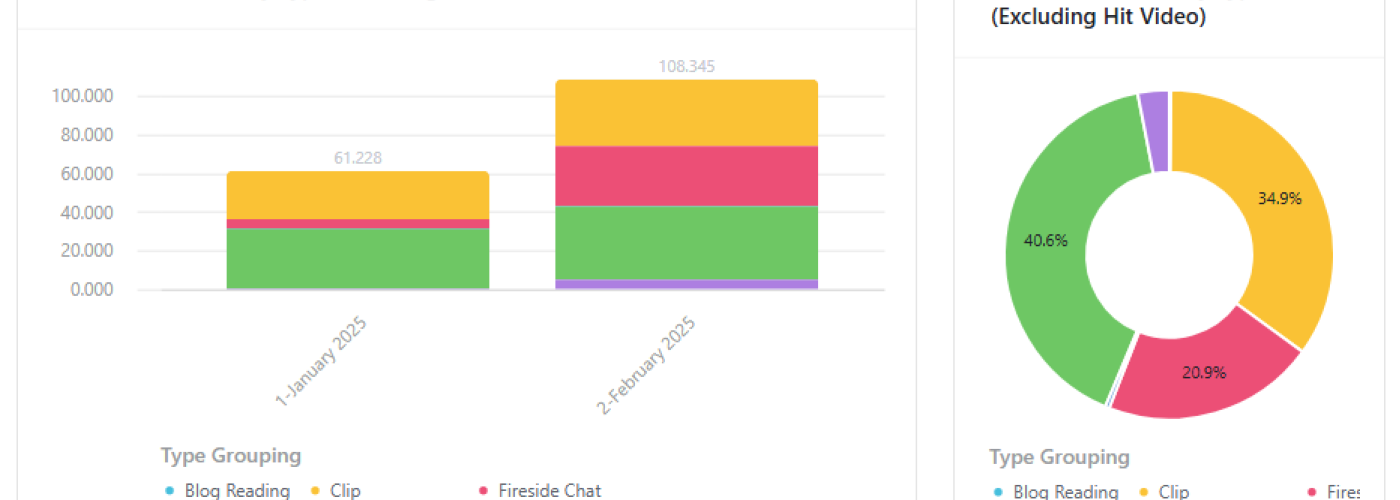
187 Videos in 59 Days. How I Grew My YouTube Channel Exponentially (& How You Can Too)
Over the past 59 days, I published 187 videos and in this video, I'm going to share with you, the incredible watch hour results that pushed me over the 100 subscriber count, now 176, and what you can learn from my challenge for growing your channel.
I've also sliced this data to reveal how old, new, and recent videos contributed to this successful outcome. I'm going to break it down into the type of video published and how each type of video contributed to the total watch hours as part of my goal to get monetized this year.
From there, I'm going to do a deep dive into the top-performing videos to see what was most effective and why I think those videos were successful.
I'll be sharing specific actions to help us both grow our channel for the months ahead throughout the video.
If you want to jump around, I've included video chapters for each section below, including a few bonus sections with additional insights and experiments.
So, let's answer the question, what happened after publishing 187 videos? What results did I generate from my volume of activity?
THE RESULTS: January and February 2025 Watch Hour Totals
Compared to my prior months and years, my 2025 watch hour performance has been incredible. Taking YouTube seriously makes a difference.
My 2024 video watch hours for the whole year was 242.
For the first two months of 2025, I achieved 298.9 watch hours! And 237.5 was just from February!
It's pretty wild that in two months I surpassed all of last year and that in one month, I almost did the same volume as 2024.
So, I'm a bit stunned at how much success I've had this quickly. And, a major contributor to this success was publishing my most popular video of all time, in view count and watch hours. I'll dive into that hit video deeper, later in this video.
Here's the graph of watch hours by month from the beginning of 2024 through February 2025.
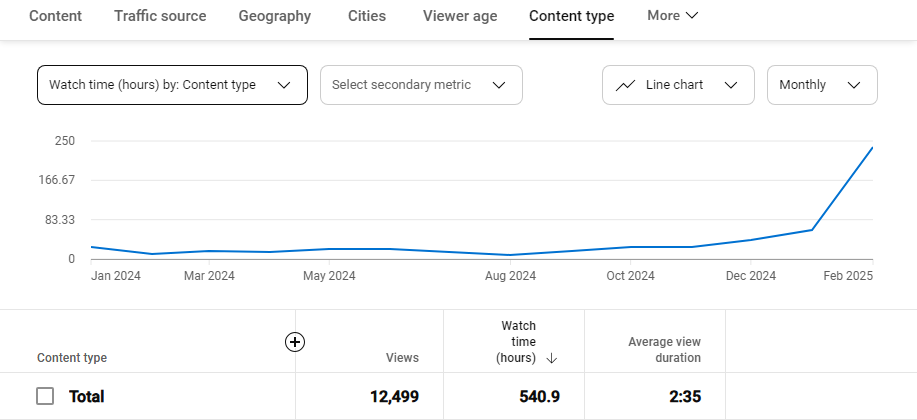
And, I also passed the 100 subscriber milestone!
Thank you to everyone who subscribed to help make it happen.
I'm now sitting at 176 subscribers. It took me 7 years to get 68 subscribers and in 2 months I've more than doubled it. Pretty awesome.
Hit videos and a volume of activity make a difference. But, it's important to tease out the specific lessons so we make sure they help us keep growing. We'll do that as we dive in deeper.
YouTube also celebrated my achievements with these two notifications.
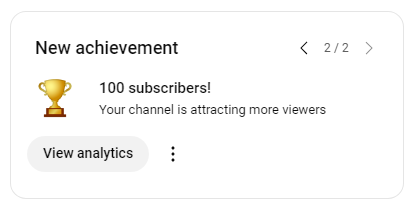
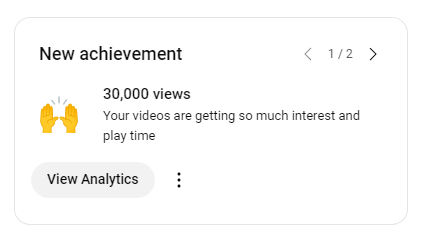
Now that you know the outcome, let's dive into these results, slicing the data to see which types of videos moved the needle.
I already explored January in a previous video so I'll focus on what happened across both months in total and then somewhat on just February.
We'll also explore how new and old videos each contributed to the outcome, we'll break down watch hours by video type, and we'll also explore subscriber growth.
From there, We'll dive into the specific videos that performed the best, including my hit video, and what made them successful.
More Results: Types of Videos I'll Be Creating Next Month
So I published 187 videos this year so far.
110 of those videos were in February. Here's the breakdown.
-
8 fireside chat vlogs.
-
1 flashback travel video
-
12 videos from an old freelance course I did
-
2 podcast episodes
-
87 podcast episode clips
That's a lot of videos but that is enabled because I have the unfair advantage of having a podcast library of episodes to pull out clips.
Based on my January results, I leaned heavily into clips because I saw the biggest upside in it from my previous activity.
But, the success in February tells a new story and that means I'll be pivoting.
Take a look at the watch hours by video type. When we look at both results with the hit video and without, it's clear that the upside of fireside chat videos is dramatically better than clips.

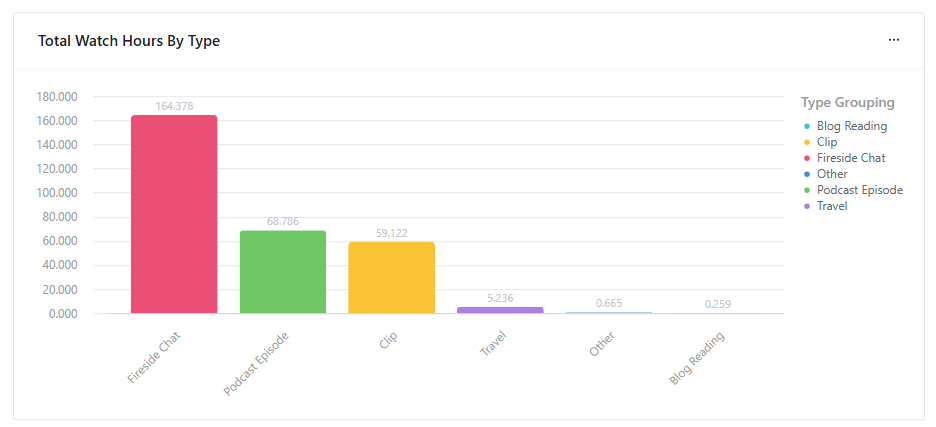
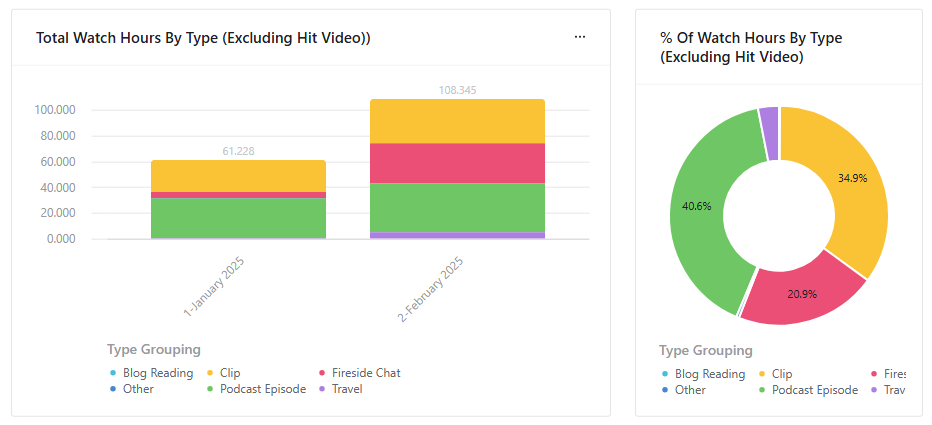
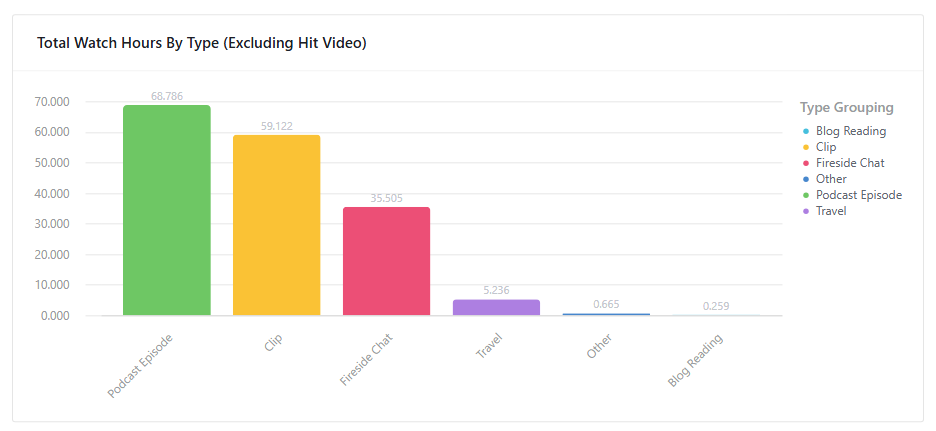
Those graphs show the total number of watch hours by category, so if we average those watch hours by the number of videos in each category, we get the following result.
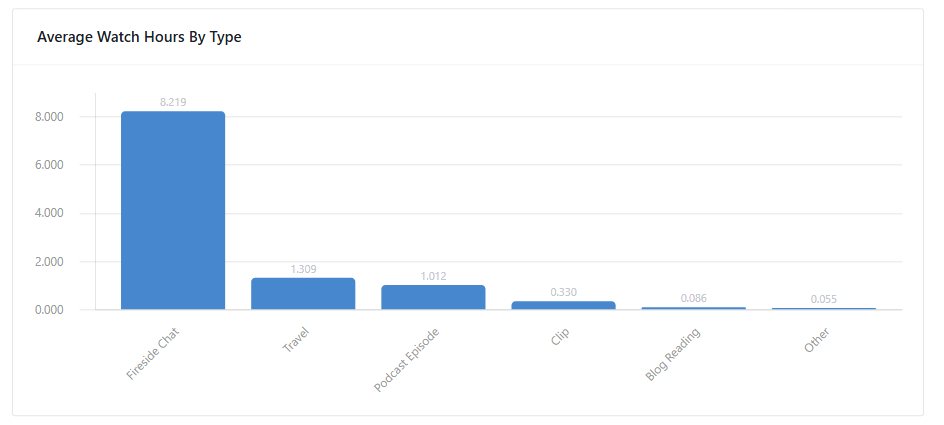

Even without the hit video, the fireside chat blogs perform way better than everything else I've done.
I don't have very many travel videos, but it is interesting how effective they've been so far. I've got a ton of video footage from my trip to Honduras, so I think producing some videos for that trip will be worthwhile.
So, how will I pivot my YouTubing next month based on this insight? I estimate I spent 25-30 hours generating clips in February. For March, I'm going to cut that back dramatically and apply that recovered time toward vlogs or what I'm calling fireside chats.
The battle between video types continues!
I don't want to give up on clips entirely because they have produced 60+ watch hours in 2025 so far, but I do want to adjust my time, putting more of it towards videos that have more potential. I plan on cutting back to around 30 clips for March and working them around other more important videos. We'll test this hypothesis and see if it holds in next month's video report!
Before we explore other lessons we can find in the data, let me share a few thoughts about how a volume of videos generates more YouTube exposure.
Does a Volume of Videos Increase Exposure?
There is a tangible benefit to posting a large volume of videos because YouTube will give you more exposure with impressions. Every video seems to get some amount of impressions even if it is just a few hundred.
YouTubing is like deep-sea fishing. The more lines you have in the water, the better chances you have of catching something. Take a look at the video impressions and how much they go up the more videos I publish.
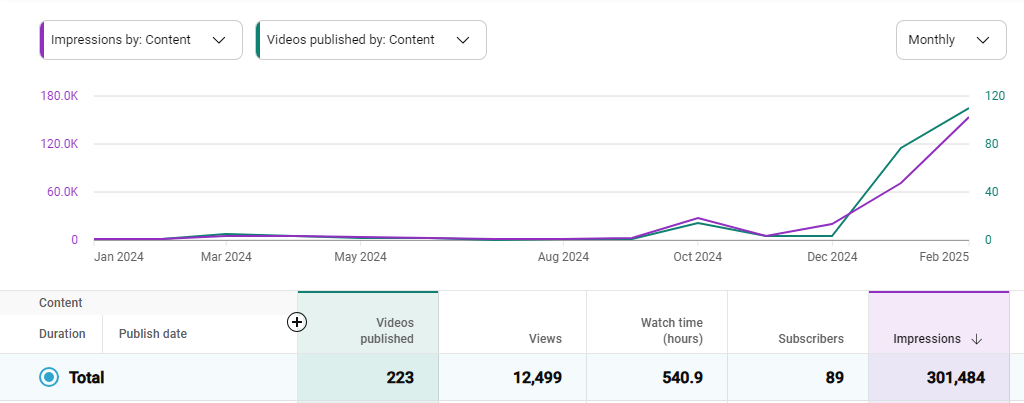
Every video is going to get at least a few hundred to a few thousand impressions and that means the more videos we publish the more exposure we get.
Just in February, I got 154k impressions. If I was paying for these impressions, it might cost me $500-$1,500, so that's pretty awesome that I got that much exposure without any cost at all. As a marketer who has so often worked to promote the content I created, it's amazing that YouTube promotes the content we create. It's free advertising.
I do wonder if YouTube accounts are given an impression budget, meaning they limit the number of impressions per day or month. If you have any insight on this matter, post in the comments below.
This insight implies the next thing we'll explore, which is how age affects watch time. The answer seems obvious, but let's verify it with the data.
More Results: How Does Video Age Affect Watch Time?
If we look at my 2025, data, here is the breakdown of watch time by video age.
I've grouped it into three categories. The first is new, which means it was published during the same month, in this case, February. I'm defining recent as the three months prior to February, so that would be January, December, and November. And then anything older is labeled as old.
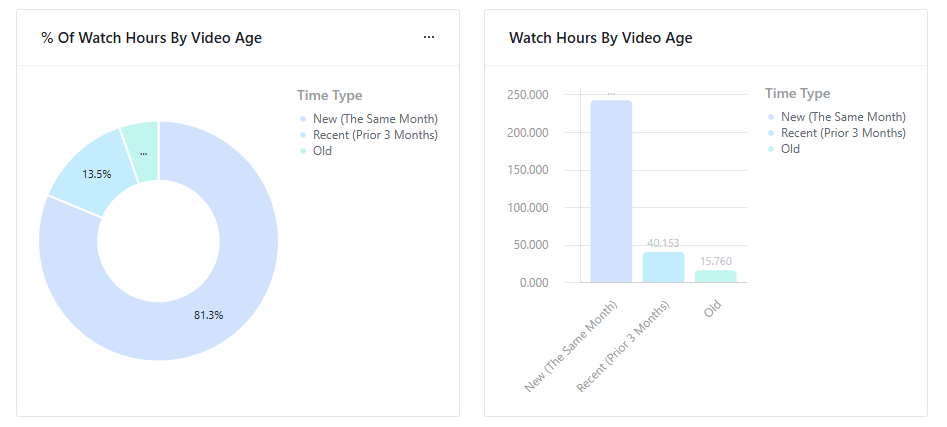
That graph shows the number of watch hours in total, by age grouping. If we normalize the number based on the average number of watch hours per video, here is what we get.
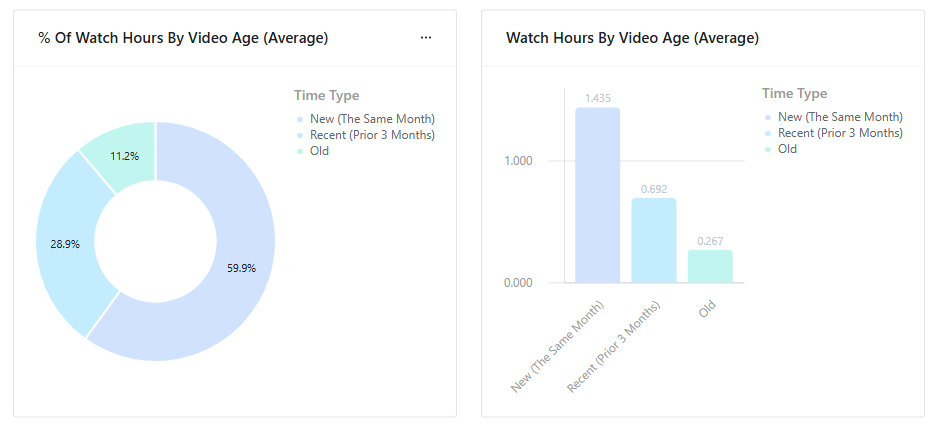
New videos dominate, but when I average it out against the number of videos in the category, new videos are not as dominant as they first seem.
As this year unfolds, what I will be watching for is whether or not this changes dramatically as I produce more hits and as my video library grows. I've added more videos in 2025 than I had in the 7 years prior so as those videos move into the recent and old category, it's going to have a big effect. That will be something worth paying attention to in June of this year.
Alright, let's keep exploring the data. What does the length of the video tell us?
More Results: How Is Watch Time Effected by Video Length?
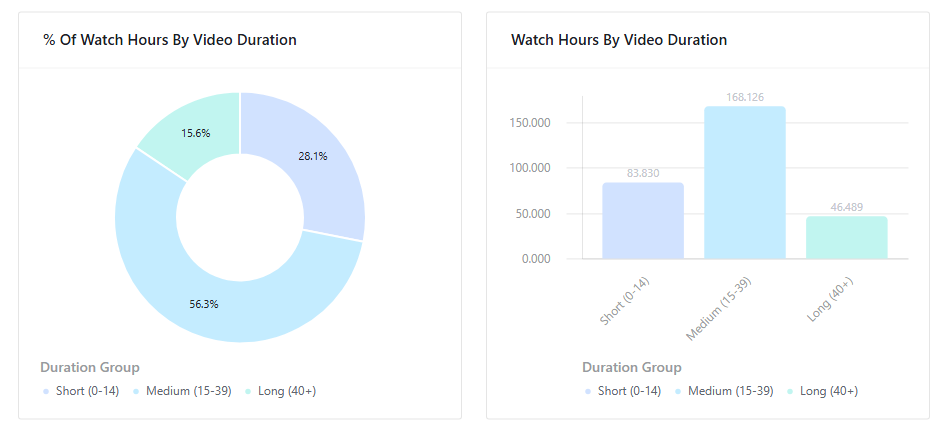
I've defined short as any video under 14 minutes, medium as a video 15 to 39 minutes in length, and long as 40 minutes or more. Based on total watch time, medium length videos perform the best. Let's see what happens when we average out the numbers.
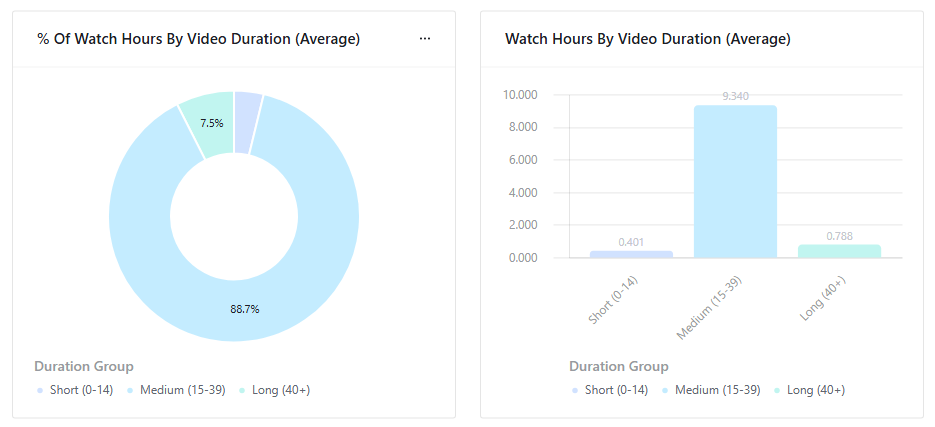
Wow. This becomes even more pronounced. My medium-length videos dominate! But, I wonder, if I take my hit video out, how does it alter this?
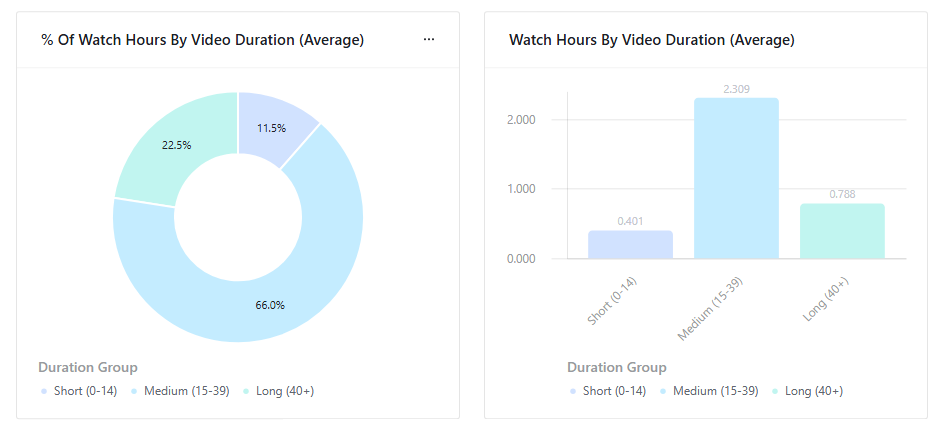
Wow. Even without my hit video, medium-length videos dominate. As I produce fireside chat vlogs in March, I'm going to aim for at least 15 minutes in length.
Alright, so we've surveyed these high-level reports, let's do a dive into the top-performing videos and why they worked.
Results: Top Performing Videos
Since YouTubing is like deep sea fishing, we're going to do a YouTube video fish weigh-in, to see which of the videos had the most watch hours and explore why they did so well.
How am I defining a hit video? I've created several tiers to clarify.
A level 1 hit video is 5-15 watch hours.
A level 2 hit video is 16-50 watch hours.
A level 3 hit video is 51-150 watch hours.
When I rise above level 3 I'll add some other tiers.
So, my biggest hit was a level 3 hit video. This is now my most-watched video in watch time and views for all time on my channel. And it was quick.
So, a little context. In January of this year, I decided to take YouTube seriously and as part of that effort, I launched a challenge to publish a ton of videos this year. Once January was over, I did a YouTube report video like this one and it was a huge hit.
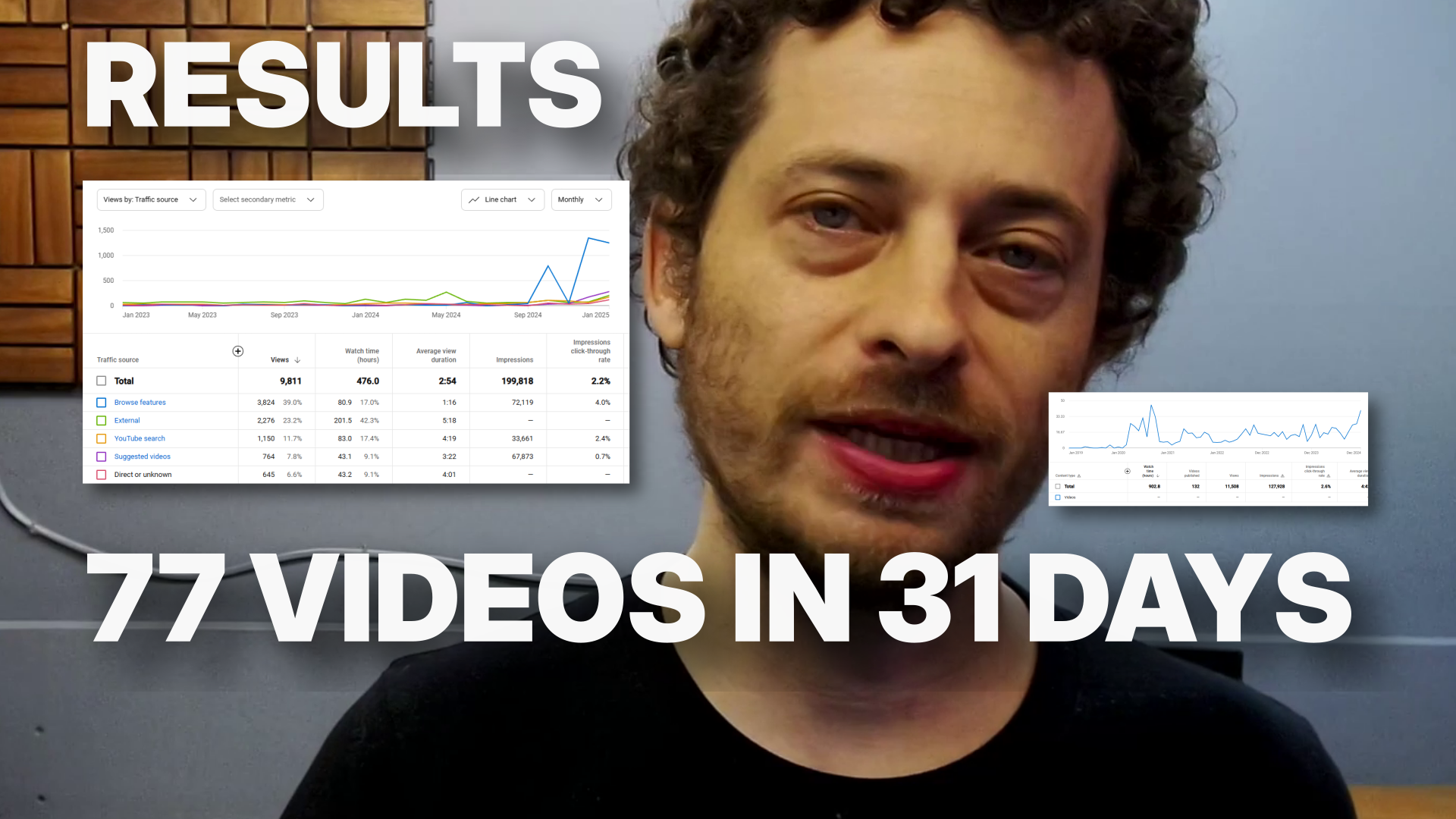
The watch hours shot up and is now my top watched video of all time in both views and watch hours. As of recording this, my top video has 2.1k views and 130.6 watch hours. It's my first video to break 100 watch hours and it's only been out a month.
Here's the analytics for the video.
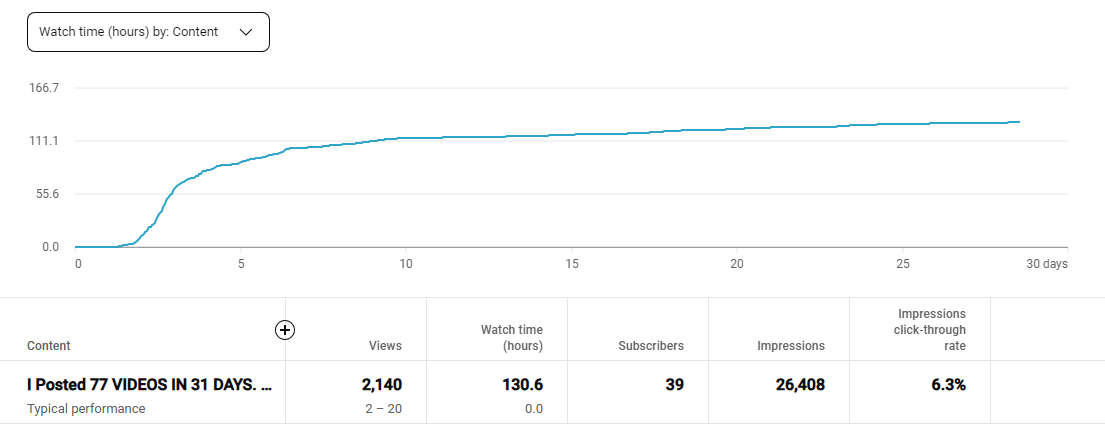
This top-performing video generated half of all watch hours that I got in 2025, in one video, in one month. That's pretty wild and a powerful insight into the potential of hit videos.
And each day it continues to add views and watch time.
Now, what's also interesting is that the video didn't get much traction in the first 2 days. But, on day 3 it blew up with 47.35 watch hours. Now it maintains around an hour per day of watch hours.
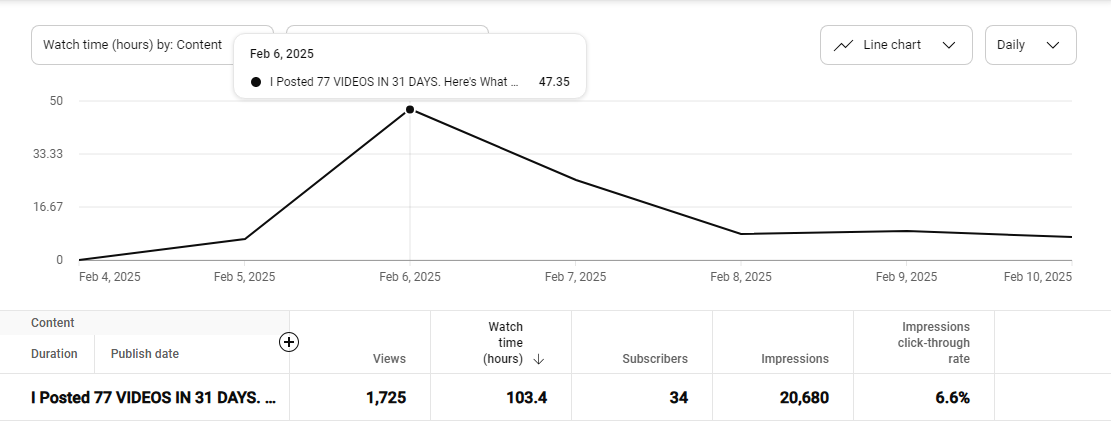
Publishing outlier-level success videos is going to be the key to quickly getting to 4K watch hours faster. So for March, I'm going to start with videos I think are most likely to be hits. I'll then fill in the rest of the month with scheduled podcast episodes, passion content, and clips.
Why do I think this video was a hit? I think it really comes down to a rare idea. YouTubers have posted about challenges and analytics, but there are almost no YouTubers who have done a challenge as ambitious as I have done.
So, doing a challenge is enticing, but doing a challenge that no one has done provides even more novel insights.
This video I'm recording right now is a follow-up to that video and we'll see if I'm able to replicate my success once again by continuing the challenge at an even higher level.
The power of a challenge, even if it's not as intense as what I have done, is that it gives you something worth talking about in a future video. In my case, I was able to leverage podcast clips as a way to publish high volumes of videos with fewer hours to achieve the challenge.
How could you leverage this approach? Figure out what is something that would be hard for someone else to do, but much easier for you to do.
In this case, it was a YouTube challenge, but it could be anything. If you work on an Aircraft carrier, it would be much easier for you to make a video on it than it would for me.
In my book, Path of the Freelancer, I talk about how doing hard things is one way to differentiate.
Figure out what your hard thing is and do that. Then, make videos about the challenge.
Retrospective: What If I Only Did the Top Watch Hour Videos?
If I wanted to succeed in YouTube with less time invested, what are the exact videos I could have produced in February while ignoring everything else? How do we apply the 80/20 Pareto principle?
Let's see what my hit videos did to see how many watch hours I could have generated with the least amount of time.
-
128.872
-
15.353
-
12.832
-
12.399
-
8.878
-
8.669
-
7.179
My top 7 videos generated 194 watch hours out of 298 for 2025. So, if I only spent time on those top seven, I would have missed out on over 100 watch hours.
Now, I have 59 watch hours from 25 videos that have less than 5 watch hours but more than 1.
So, if I worked on the top 32 videos, I would have generated 253 of the 298 watch hours, 84%.
What's wild is that 46 watch hours came from a collection of 254 videos with less than 1 hour of watch time.
These numbers include all videos, so let's narrow it down to just videos that were published in February.
187 watch hours of 237 came from 6 hit videos. If we include videos over 1 watch hour, we're looking at 211 watch hours from 17 videos. 125 videos with less than 1 watch hour each contributed about 25 watch hours in total.
So, one of my takeaways here is that if I keep doing what I'm doing, I should be able to get monetized in a year or less. So really, the key is to figure out, what can I shift to accelerate the process to be much quicker. Publishing a high volume of videos is going to be important, but if I can narrow in on the videos that will produce the most results, that seems to be my ticket to fast-forwarding this journey.
Top 12 Most Popular Videos
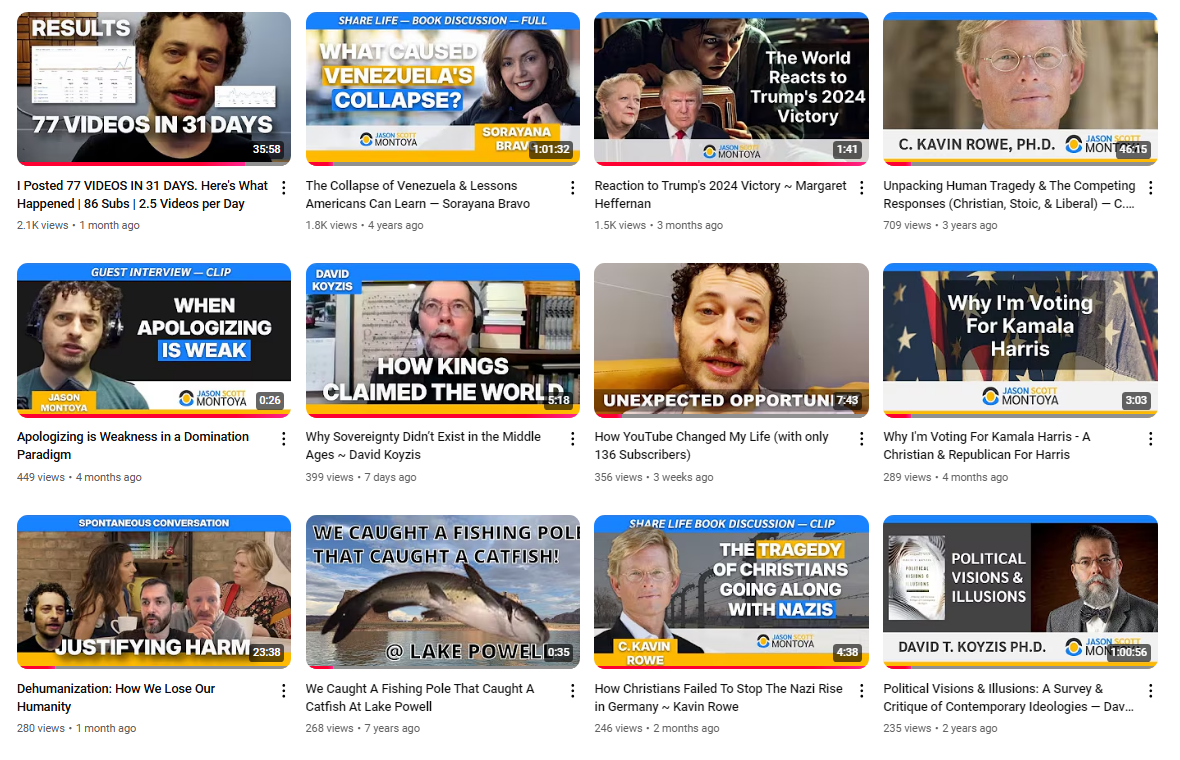
If you go to my channel videos, and sort by most popular, here are the top 12. Three of my top 12 were published in February and two were in January. So, that's pretty cool. My challenge to myself is to try and replace my top 12 with recently published videos. As I have more and more success that will be a harder and harder feat, but as a small YouTuber it's a great challenge to chase.
Results: 176 Total Subscribers
I want to briefly talk about subscribers. When I started the year, I had 68 subscribers, which took me seven years to get. And now, I'm sitting at 176 subscribers and have hit over forty thousand views as a channel!
-
My total view count is 42,517. So, that means I'm getting 1 subscriber for every 242 views. To get to 1,000 subscribers, I'll need to get another 199,408 views.
-
If I do it by watch hours instead, I'm getting 1 subscriber for every 7.5 watch hours, which means I need another 6,180 watch hours to get to 1k. This is a clue that I'm moving faster on watch hours than I am on subscribers and may need to adjust my strategy to compensate.
One idea for you is to turn on your logo subscribe button. It seems like once I did that, it helped me get more subscribers. You'll notice it in the bottom right-hand corner of this video. You can find it under the channel customization at the bottom, under the video watermark section. I have it on for the entire video.
YouTube Shorts Experiments
Let's talk a little about YouTube Shorts.
This past month, I published two of my most popular YouTube shorts ever. One has 11k views and another has over 1k views. My most popular short before that was around 600 views. Unfortunately, these don't help with watch hours. My hit Short has 41 watch hours which is a pretty incredible feat since the video is only 7 seconds long. I did get 12 subscribers from these shorts, so that was a confirmation of my hypothesis that Shorts are a great way to get subscribers.
Here are a few other insights on YouTube shorts.
-
It seems to me that shorts are a good way to stimulate past published videos to get them more traction, particularly those videos we think should have done good, but did not.
-
Posting Shorts seems to stir up activity with other videos, including ones that are not directly related to the shorts
-
Editing shorts after the initial views, to shorten them to around the average length watched is something I tested out, but didn't seem to have much of an impact.
-
Do Shorts help generate watch hours? Not really. They do seem to lead to views, but the views didn't seem to stick around. I want to experiment with this more in the future, but for now, my main purpose in Shorts is to generate subscribers.
-
The keys to reel success seem to be rewatches. Give something good and Leave them wanting more. I edited some of the shorts based on the average view times of the initial watches, trimming them down.
Other experiments
I also tried going live this month for the first time and I'm testing out new formats of videos to learn, see how they do, and have fun. Now is a great time for me to experiment because there's no downside to doing so.
So, this month I went deep into the archives from 22 years ago. My father took me to Alaska and I made a travel video. The problem is that was before YouTube was around and all these fun videos I made long ago, never found their way online. Some of them are not worth sharing, but the Alaska video is a great one for those interested in the topic. The pacing is good and it stays interesting. Compared to some recent similar videos, I think it's better, although the quality of the footage is not since I shot it on this old Sony Handycam.
One other experiment I'd like to test is doing a vlog every day, or at least 3 times per week. If I can pull it off, I may try and do 3 a day for a month at some point. I have such a vast library of blog posts, books, and outlines that it would be possible for me to do something like this. But, I want to get monetized first, so that effort has a chance to earn an income and be worth putting in all that focus and effort.
Surprise: I Didn't Expect This Type of Dominant Google Rankings
For people I interview who don't have strong digital footprints, these videos, especially the volume of clips I'm posting, get ranked on Google. The others with more presence have some of the videos in Google listings for their name, but not quite like less active folks.
But this is cool to know because I love introducing people to the internet, and knowing this type of result is possible, makes it more worthwhile to do that! I'll be watching to see how much clips may drive external traffic from Google.
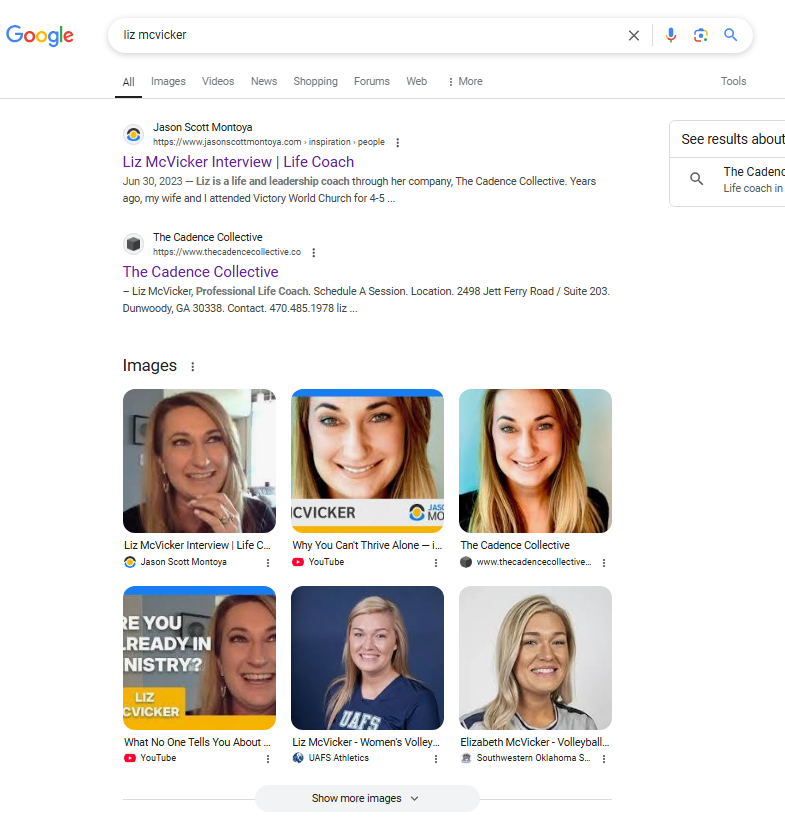
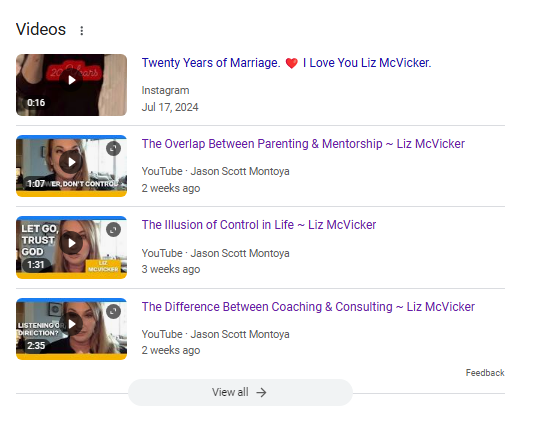
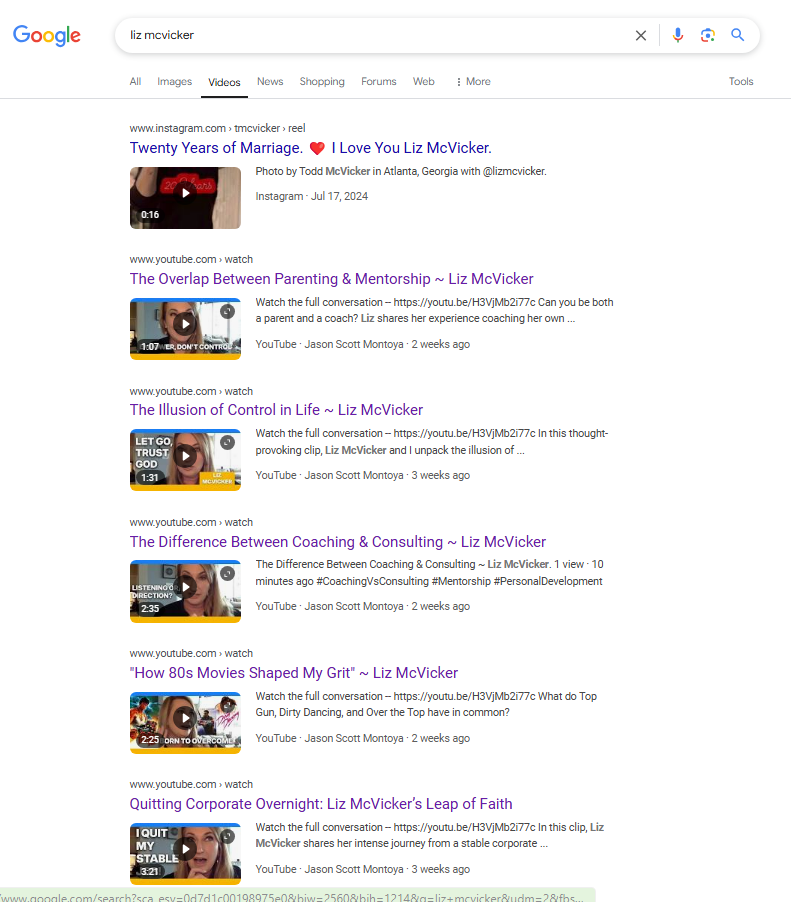
YouTube Video Success Morale Boosting
When it comes to doing YouTube, it can be a bit of a roller coaster so doing a big challenge is great because we keep moving even when something doesn't seem to have gotten traction.
Clips are nice because by posting so many, some will get traction and when they do, they boost my morale, particularly when there is not much viewing activity going on.
It's also quite interesting to go through the emotions of having a video hit it big being excited and falling back down to earth when things settle down.
End Cards
End Cards have not been as awesome as I was told they were. Perhaps it comes into effect when the numbers are much higher, but it doesn't seem to make much of a difference for smaller channels with fewer views. I did it consistently in February, and I only got 1 watch hour from them.
Creating This Video
Doing a challenge gives you something worth talking about in another video. Do things, share those things. That's a success formula. And that's what I've done with my hit video and this one.
And, knowing I was going to create this video, I worked on this script the entire month as I discovered things and ideas that came to mind. For me, I use Evernote and I created a note for the video and jotted things in it as the month progressed. So the reason it's so jam-packed with good insights is because I've been collecting them throughout the month.
Out of everything I've shared, what's been most valuable to you? And, what are some things you've discovered that have helped you grow your channel? Share in the comments below.
- Created on .
- Last updated on .